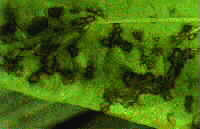Bellpepper Resistance: Evaluation of a Bell Pepper Cultivar for Resistance
 Project description and objectives:
Project description and objectives:
The past 10 years have seen the introduction of a large number of new bell pepper cultivars into the commercial vegetable market. Most of these cultivars are marketed as having resistance to one or more races of the bacterial spot pathogen, Xanthomonas campestris pv. vesicatoria. It is likely that these bacterial spot-resistant cultivars contain the Bs2 gene which conveys resistance to races 1, 2, 3 of X. campestris pv. vesicatoria. It is unlikely that the Bs1 and Bs3 genes are pyramided with the Bs2, but commercial seed companies are often reluctant to reveal this information. Unfortunately, additional races (5-10) have been identified which can defeat the resistance from the Bs1, Bs2, and Bs3 genes. Therefore, it is important to evaluate how these newer cultivars will hold up under pressure from a spectrum of X. c. pv. vesicatoria strains representing a range of races that might be present in Florida. In addition, horticultural traits are extremely important in the overall acceptability of these cultivars by the industry.
The specific objectives of this study were to use on-farm demonstration/ research plots to evaluate cultivars for a)development and severity of bacterial spot, b) horticultural characteristics, including yield, average fruit weight, "blockiness" (length to width ratio of fruit), and numbers of lobes/fruit, and c) determine the race of several pathogen strains from test plots.
 Project accomplishments:
Project accomplishments:
Cultivars varied considerably in susceptibility to bacterial spot. Jupiter, considered to be a universal suscept, was heavily infected in both experiments with a 43% disease rating at the Delray Beach site. Resistance to bacterial spot did not necessarily correlate with yield and quality measurements. These results were disseminated to clientele through two field days. Between the two locations, approximately 50 clientele participated. Educational programs included an opportunity to view and evaluate cultivars on an individual basis in the field. Clearly marked signs were used to facilitate self-guided tours through the plots. Handouts, summarizing data available the day of the field display, were distributed to clients.
Project Leaders:
- Dr. Ken Pernezny, Plant Pathology, UF, EREC Belle Glade
- Dr. Russell Nagata, Horticulturist, UF, EREC Belle Glade
- Darrin Parmenter, County Agt/Vegetables, Palm Beach Co